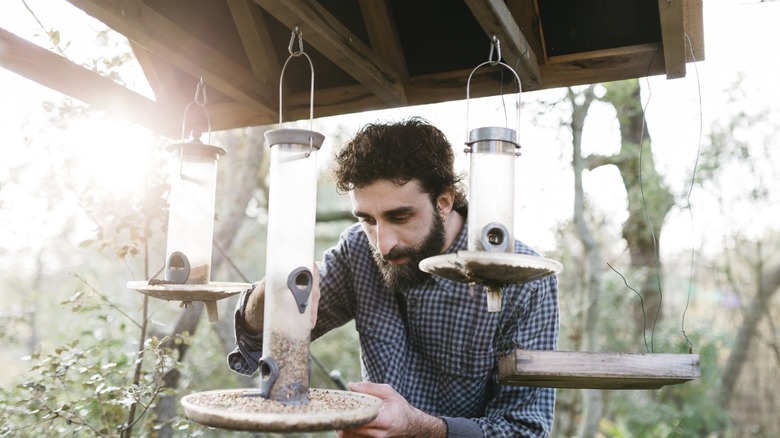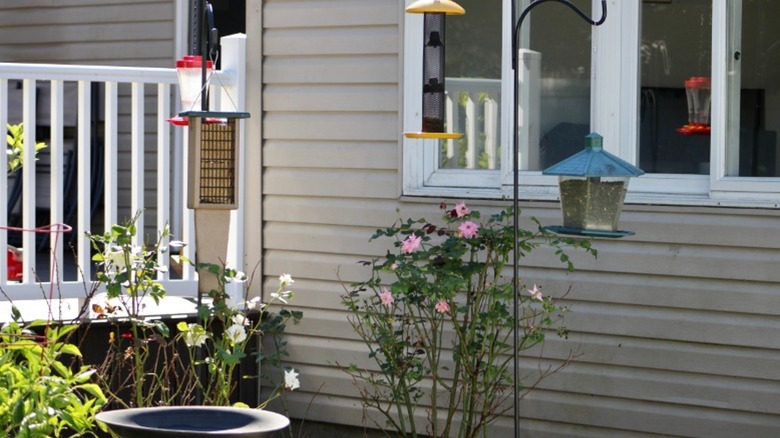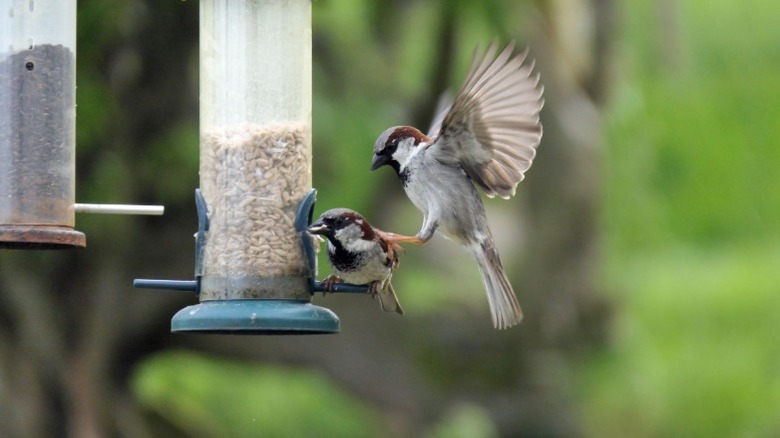What To Consider Before Putting Multiple Bird Feeders In Your Yard
Anyone who loves to attract birds to their outdoor space knows that a simple hack to get birds to flock to your yard is to hang up a feeding station. But is there such a thing as too many bird feeders in a yard? Before you decide to add multiple bird feeders around your property, consider both the positives and negatives associated with multiple feeders. While having more than one feeder can reduce congestion and competition from different birds, it can also lead to increased disease transmission.
If you're deciding whether to add a few more feeders to your yard, you need to plan ahead. Be prepared to clean each feeder in your yard regularly to prevent the growth of mold and bacteria. You also should assess whether you have the space to spread multiple feeders out on your property. Either place a feeder within 3 feet of a window or more than 30 feet away to prevent unnecessary collisions. Ideally, feeders will also be within easy distance of a brush pile, tree cover, or other protected spot.
Positive aspects of multiple feeders
Having more than one bird feeder can maximize your ability to attract a lot of awesome bird species. Instead of a one-size-fits-all feeder, collect different types of feeders to appeal to a variety of birds. For the best impact on wildlife, group similar types of feeders together. Attract goldfinches and house finches with nyjer seed, keep small birds safer with cage and tube feeders, or keep suet in a quiet spot for wary woodpeckers. Ultimately, one of the most simple methods for attracting more songbirds to your yard and garden is to offer a diverse range of food, including seeds, corn, nuts, berries, and suet at multiple feeders.
Putting multiple bird feeders around your lawn can also limit the amount of congestion that occurs at a single feeder. Birds get used to partaking in seeds and nuts if you provide them, and more will come if you continue to set them out. Keep in mind that the more birds in your yard, the more likely that conflict and aggression will arise at a solitary feeder. Having more than one in your front yard, backyard, and side yards can mitigate this issue. Providing food at more feeders may also limit contamination from sick individuals to healthy birds.
Disadvantages of having many bird feeders
While multiple feeders can be great for eliminating crowding and congestion, you also will be attracting a lot more birds to your yard. The result could be easier disease transmission between a large number of bird species. Many bacterial diseases are passed through fecal matter, which can build up heavily in a yard with multiple feeders. At times, local Departments of Natural Resources have recommended that bird enthusiasts take down their feeding stations to help prevent the spread of avian illnesses. Managing multiple feeders will mean a lot more work, involving scrubbing off debris and soaking each feeder in a diluted bleach solution.
Keeping more than one bird feeder in your yard will also increase the likelihood of conflict. Although multiple feeders can stop crowding at single feeders, it's also likely to bring together bird species that don't get along with each other. For example, grackles are an aggressive blackbird species known to steal food from other birds at feeders. There are other common birds you never want to see at your bird feeder, like house sparrows that try to hog food. Remember that multiple feeders in your yard may lead to more encounters with undesirable visitors.


